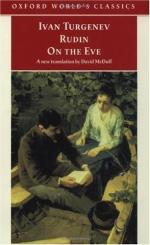|
This section contains 6,133 words (approx. 21 pages at 300 words per page) |

|
SOURCE: Gregg, Richard. “Turgenev and Hawthorne: The Life-Giving Satyr and the Fallen Faun.” Slavic and East European Journal 41, no. 2 (summer 1997): 258-70.
In the following essay, Gregg investigates the influence of Nathaniel Hawthorne on Turgenev's later short fiction.
I
In temperament, background and—in the loosest sense—philosophy Nathaniel Hawthorne and Ivan Turgenev might seem to stand at the antipodes. True, the fiction of both writers reflects a largely pessimistic view of the human condition. But if in his most characteristic works the reclusive New Englander avoided realistic modes of representation, turned to the haunts of his ancestors for inspiration, and explored such “morbid” themes as sin, guilt, remorse and retribution, Turgenev as novelist hewed to the canons of realism,1 depicted a wide variety of contemporary settings and—true to his liberal, secular and essentially rationalistic view of life—shunned the mysterious, the uncanny corners of human experience. To...
|
This section contains 6,133 words (approx. 21 pages at 300 words per page) |

|


